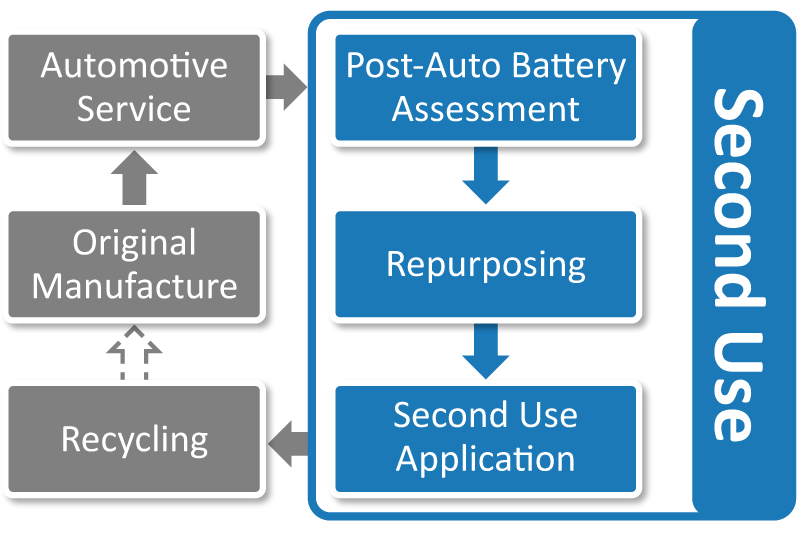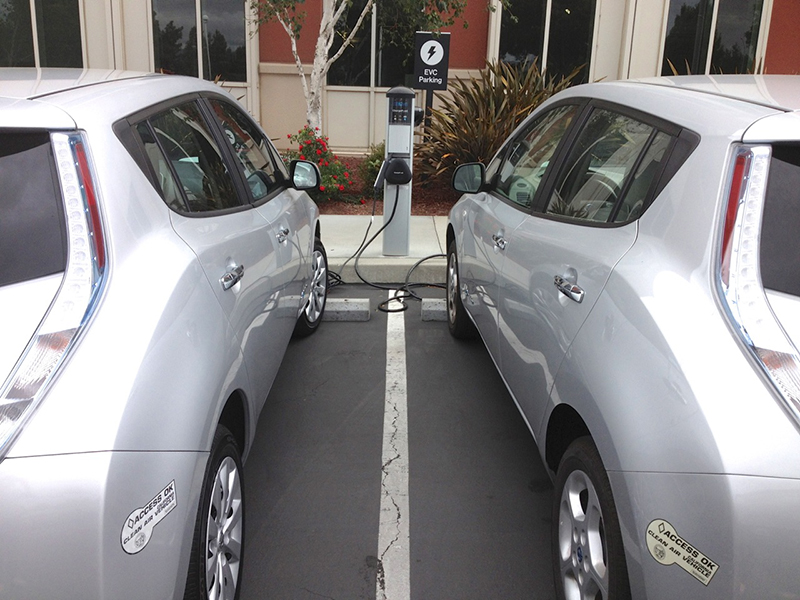Battery Second Use for Plug-In Electric Vehicles
Battery second use (B2U) strategies in which a single battery first serves an automotive application, then once deemed appropriate is redeployed into a secondary market could help overcome lithium-ion battery cost barriers to the deployment of both plug-in electric vehicles (PEVs) and grid-connected energy storage.
By extracting additional services and revenue from the battery in a post-vehicle application, the total lifetime value of the battery is increased, and the cost of the battery can be shared between both the primary and secondary users. Such battery use strategies would not only reduce the nation's dependence on foreign oil and emissions of greenhouse gases by increasing PEV adoption, but would also improve the reliability, efficiency, and cleanliness of the grid by advancing the deployment of grid-connected storage.
Recognizing this potential, the U.S. Department of Energy's Vehicle Technologies Office has funded NREL to investigate the feasibility of and major barriers to the second use of modern lithium-ion PEV batteries.

PEV battery life cycle with second use
B2U Repurposing Cost Calculator
Available for free download, this tool enables users to explore the effects of different B2U repurposing strategies and assumptions on economics.
Download ToolAnalysis
The resultant research identified and answered several high-level questions critical to understanding the viability of B2U:
- When will used automotive batteries become available, and how healthy will they be?
- What is required to repurpose used automotive batteries, and how much will it cost?
- How will repurposed automotive batteries be used, how long will they last, and what is their value?
The answers uncovered by NREL researchers reveal that the second use of PEV batteries is both viable and valuable. They also suggest that B2U could become an important part of both the automotive and electricity industries. However, the economic margins that make second use viable are often small, and thus several factors could affect this conclusion. Availability of onboard diagnostics data and accurate assessments of automotive and second use battery degradation stand out in particular.
For more information, see the summary of analysis findings.
Laboratory and Field Evaluation
The conclusions drawn from NREL's analysis are strongly sensitive to battery degradation predictions. To validate NREL's predicted first and second life performance, in-lab evaluation of batteries is necessary. To this end, NREL is conducting battery life evaluation in its laboratories, and has partnered with the Center for Sustainable Energy and the University of California, San Diego (UCSD) to install a flexible second-use field testbed on a microgrid.
Research at both UCSD and NREL is ongoing. As evaluation continues, researchers will assess the real-world performance and degradation characteristics of used batteries to learn more about optimizing deployment strategies.
Conclusions and Recommendations
The collective findings of this project to date illustrate the possibility of B2U strategies becoming an important part of both the automotive and electricity industries. While NREL's analysis does not suggest that B2U will significantly reduce the upfront cost of PEVs, it does show that B2U can eliminate end-of-service costs for the automotive battery owner and provide low- to zero-emission peaking services to electric utilities reducing cost, use of fossil fuels, and greenhouse gas emissions. Thus, the overall benefit to society may be quite large.
This study has also highlighted the need for additional B2U research and development work to make B2U strategies a reality. The authors' have provided their recommendations for the industry below.
Automotive and Battery Original Equipment Manufacturers (OEMs)
Automotive and battery OEMs should include onboard diagnostic capabilities that accurately track the state of health of individual cells and pledge to share this data with repurposers. This will enable accurate identification of a battery's value and its viability for second use service. In addition, degradation and related statistics from automotive service should be quantified and shared.

Systems Integrators and Installers
Systems integrators and installers should work to develop large megawatt-scale energy storage system (ESS) solutions for repurposed PEV batteries that minimize integration, balance of system, and installation costs. These systems should monitor the health of individual modules and enable efficient replacement of individual faulty or end-of-life modules in the field.
Utilities and Regulators
Utilities and regulators should develop policies that encourage the use of ESS, particularly as peaker plant replacements, and that will support access to sufficiently large markets for repurposed batteries. Guidelines should be defined for minimum required system durations in these roles. Enabling the use of assets with durations as little as 1 hour would also be helpful. Demonstrating both new and repurposed batteries in these roles will be critical.

Laboratories, Universities, Future Repurposers, and other Third Parties
Battery degradation in both the automotive and second use environments is a critical uncertainty in the analysis of B2U strategies. Quantifying degradation of battery packs in first and second uses and developing tools to assess state of health and predict future battery degradation are therefore of great value to the field. Repurposing processed batteries should be demonstrated to confirm that a product of adequate reliability can be provided at low cost. Life cycle analyses that show the overall benefit to society of B2U strategies are important to demonstrate value that may not be captured in economic calculations.
Research Partners
To collect their expertise and apply it to this research effort, NREL partnered with utility companies, universities, hardware developers, PEV research centers, microgrid field examiners, and automotive manufacturers: These organizations include:
- BMW
- California Center for Sustainable Energy
- UC Davis Plug-In Hybrid Electric Drive Research Center
- Public Interest Energy Research (PIER)
- California Energy Commission
- University of California, San Diego (UCSD)
- UC Berkeley Transportation Sustainability Research Center (TSRC)
- AeroVironment (AV)
- San Diego Gas & Electric (SDGE)
- Southern California Edison
Contact
For more information about NREL's PEV battery second use research and analysis, contact Ahmad Pesaran, 303-275-4441.
Share

